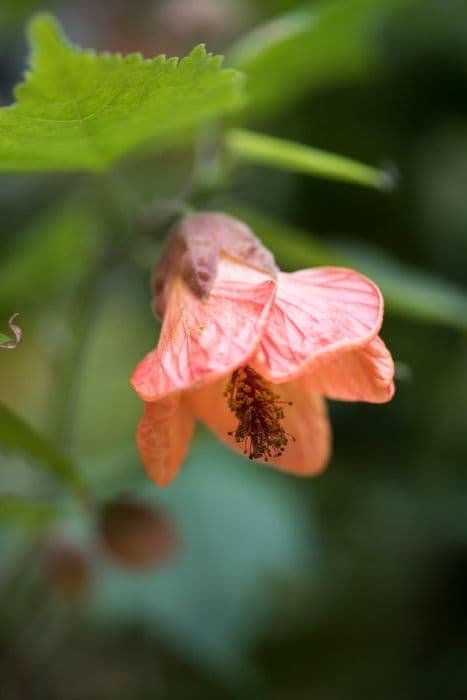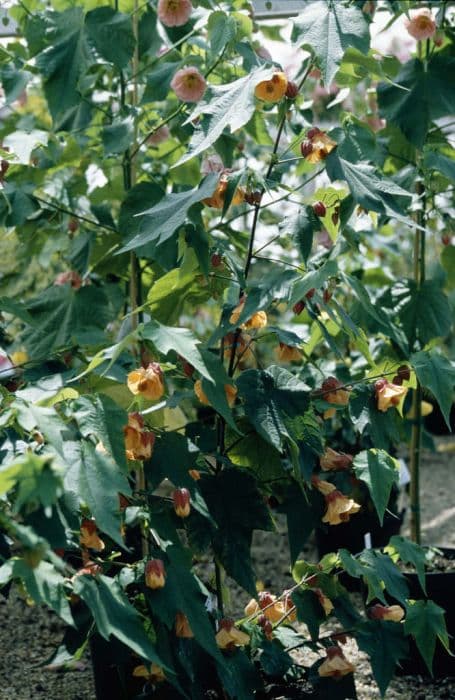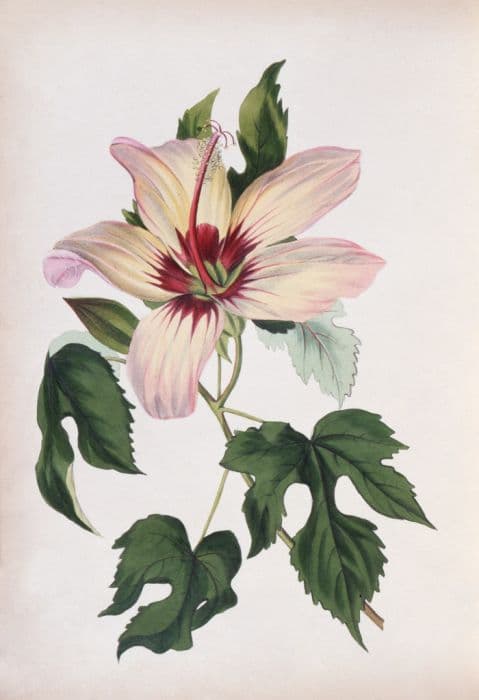Rose Mallow Lavatera trimestris 'White Beauty' (Beauty Series)

ABOUT
Lavatera trimestris 'White Beauty', often referred to simply as 'White Beauty', is renowned for its striking floral display. The plant's most distinctive feature is its large, showy flowers that exude an elegant simplicity. These blossoms are pure white in color, creating a bold contrast against the green backdrop of the foliage. The flowers have a classic, saucer-shaped form that is typical among its kind, radiating an almost ethereal glow in the garden. Each bloom has a delicate texture, with petals that are both soft to the touch and visually inviting. The center of the flowers is usually adorned with a subtle, intricate pattern of veins that lead to a central hub, adding depth and texture to the floral structure. Moreover, the flowers are profuse, covering the plant in a lavish display of white that can be quite stunning during its peak blooming period. The leaves of 'White Beauty' amplify the plant’s allure, with a lush green hue that provides a vivid contrast to its pristine flowers. They are generously sized, somewhat heart-shaped, with a gentle serration at the edges that gives them a slightly ruffled appearance. The foliage is dense enough to create a robust canvas for the flowers, yet it is arranged in a way that allows the blossoms to take center stage. Overall, the appearance of 'White Beauty' is one of grace and splendor, with its exquisite white flowers and full green leaves combining to offer a lush and romantic visual. It is a popular choice in gardens for creating eye-catching spots of brightness and for bringing a sense of purity and peace to the landscape.
About this plant
 Names
NamesFamily
Malvaceae.
Synonyms
Annual Mallow, Rose Mallow, Royal Mallow, Regal Mallow.
Common names
Lavatera trimestris 'White Beauty'.
 Toxicity
ToxicityTo humans
Lavatera trimestris, commonly known as the Annual Mallow, is not widely recognized as a poisonous plant to humans. There is little documentation of its toxicity, and it is generally considered to not be harmful when touched or ingested in small quantities. However, as with any plant, individual reactions can vary, and some people might experience mild stomach upset if they consume parts of the plant. If an individual has a particular sensitivity or allergy to the plant and experiences symptoms such as gastrointestinal distress, it is advisable to seek medical attention.
To pets
The Annual Mallow is not typically known to be toxic to pets. Most animals can be around the plant without any adverse effects. However, it's always possible for individual pets to have a sensitivity or allergic reaction to any plant. If a pet were to ingest a large quantity of the plant, they might experience mild gastrointestinal upset, such as vomiting or diarrhea. If such symptoms occur and are persistent or severe, it is recommended to consult with a veterinarian.
 Characteristics
CharacteristicsLife cycle
Annuals
Foliage type
Deciduous
Color of leaves
Green
Flower color
White
Height
3-4 feet (91-122 cm)
Spread
1-2 feet (30-61 cm)
Plant type
Herb
Hardiness zones
2-9
Native area
Mediterranean
Benefits
 General Benefits
General Benefits- Ornamental Appeal: Lavatera trimestris 'White Beauty' provides a lush display of white flowers that enhance garden aesthetics.
- Attracts Wildlife: This plant is known to attract pollinators such as bees and butterflies, which are beneficial for the ecosystem.
- Easy to Grow: The plant is straightforward to cultivate, making it suitable for beginner gardeners.
- Drought Tolerance: Once established, it can withstand periods of low water, ideal for water-conservation landscapes.
- Fast Growth: It grows quickly, providing a rapid display of flowers and filling in garden spaces.
- Adaptability: The plant can adapt to a variety of soil types as long as there is good drainage.
- Seasonal Impact: With its summer blooming period, it provides seasonal interest in the garden.
- Low Maintenance: Lavatera trimestris 'White Beauty' requires minimal maintenance, such as occasional watering and deadheading.
 Medical Properties
Medical PropertiesThis plant is not used for medical purposes.
 Air-purifying Qualities
Air-purifying QualitiesThis plant is not specifically known for air purifying qualities.
 Other Uses
Other Uses- Lavatera trimestris 'White Beauty' can be used as a natural dye for fabrics, imparting subtle shades of pink or mauve depending on the mordant used.
- Due to its quick growth and large leaves, the plant can be used as a temporary privacy screen in gardens or on patios.
- The stems of Lavatera trimestris can be turned into a fibrous material suitable for making paper or eco-friendly packaging.
- Its dried flowers can be used in potpourri mixtures, providing a light floral fragrance to rooms.
- When placed in a water feature, the fallen flowers of White Beauty offer an ephemeral beauty as they float on the surface, creating a decorative effect.
- Beekeepers might plant White Beauty in the vicinity of hives as its blooms are attractive to bees and can contribute to honey production.
- Its petals can be used in crafting, either pressed for inclusion in bookmarks and cards or mixed into homemade candles for aesthetic appeal.
- The blooming plant can serve as a living mulch, suppressing weeds and conserving soil moisture in garden beds.
- In artistic photography, Lavatera trimestris can provide a striking white backdrop or subject matter for botanical-themed compositions.
- Seed pods from White Beauty can be dried and used as natural decor in wreaths or as part of table centerpieces.
Interesting Facts
 Feng Shui
Feng ShuiThe Tree Mallow is not used in Feng Shui practice.
 Zodiac Sign Compitability
Zodiac Sign CompitabilityThe Tree Mallow is not used in astrology practice.
 Plant Symbolism
Plant Symbolism- Pure Beauty: The 'White Beauty' cultivar of Lavatera trimestris, also known as Rose Mallow, often symbolizes pure beauty due to its large, pristine, white blossoms.
- Femininity: With its delicate flowers, Rose Mallow reflects qualities typically associated with femininity such as softness, grace, and gentleness.
- Rebirth: Rose Mallow blooms repeatedly throughout its growing season, representing the idea of rebirth or renewal.
- Fleeting Nature of Life: As an annual plant, Rose Mallow's lifecycle is short, reminding us of the transient, ephemeral nature of life.
- Protection: Some cultures believe that Rose Mallow has protective qualities, possibly due to its lush growth which offers shelter and its medicinal uses.
 Water
WaterAnnual mallow, or tree mallow, should be watered thoroughly when the top inch of soil feels dry to the touch, which typically means about once a week. However, this frequency can vary with temperature and humidity conditions. During hot or windy weather, the plant may require more frequent watering. It's important to avoid over-watering, as tree mallow does not like soggy soil. On average, use about 1 gallon of water per plant for each watering session, ensuring it is evenly distributed around the base of the plant rather than on the foliage.
 Light
LightTree mallow thrives in full sun, requiring at least six hours of direct sunlight per day. The best spot for tree mallow would be an open area free from taller plants that might shade it. The intense light helps it produce plentiful and vibrant blooms.
 Temperature
TemperatureTree mallow prefers temperatures between 60°F and 70°F but can handle temperatures as low as 50°F and as high as 85°F without issue. It is not frost-tolerant, so it is important to plant it after the risk of frost has passed or provide protection if an unexpected frost occurs.
 Pruning
PruningTree mallow benefits from pruning to encourage bushier growth and to remove any spent flowers or damaged stems. Prune in late winter or early spring before new growth begins by cutting back the stems to about a third of their height. Regular deadheading during the blooming season also promotes more blooms.
 Cleaning
CleaningAs needed
 Soil
SoilThe Tree Mallow 'White Beauty' thrives in well-draining, fertile soil with added organic matter. A mix of two parts garden soil, one part peat or coir, and one part perlite or coarse sand works well. The ideal soil pH for Tree Mallow ranges from slightly acidic to neutral, around 6.0 to 7.5.
 Repotting
RepottingTree Mallow 'White Beauty' does not often require repotting as it is typically grown as an annual. However, if grown as a perennial, repot it every 2 to 3 years, in spring, to refresh the soil and encourage healthy growth.
 Humidity & Misting
Humidity & MistingTree Mallow 'White Beauty' is tolerant of a wide range of humidity levels and does not require specific humidity conditions. It is generally adaptable to the humidity levels found in most outdoor garden environments.
 Suitable locations
Suitable locationsIndoor
Place in bright, indirect light; water when topsoil is dry.
Outdoor
Full sun, shelter from winds, well-drained soil, regular watering.
Hardiness zone
7-10 USDA
 Life cycle
Life cycleThe common name for Lavatera trimestris 'White Beauty' is Annual Mallow. The life cycle begins with seed germination in late winter to early spring, ideally after the last frost, when soil temperatures reach around 70°F (21°C). The seeds sprout and the plant develops a rosette of leaves, followed by rapid vegetative growth. Annual Mallow then enters the flowering stage, producing large, white, open-faced blooms profusely throughout the summer months. After pollination, typically by bees and other insects, the plant sets seed in the form of small capsules which, when mature, release seeds for the next generation. The plant completes its life cycle in one growing season, dying off with the first frosts of winter, relying on its seeds to propagate the following year.
 Propogation
PropogationPropogation time
Spring-Early Summer
The most popular method of propagating Lavatera trimestris 'White Beauty', commonly known as the Annual Mallow, is through seeds. This plant can be easily grown by sowing seeds directly into the garden after the last frost when the soil has warmed up to at least 60-70 degrees Fahrenheit (15-21 degrees Celsius). The seeds should be planted 1/4 inch deep in well-drained soil and lightly covered. Seedlings typically emerge within 14 to 21 days. For those desiring an earlier start, seeds can be sown indoors 6 to 8 weeks before the last frost date in individual pots or trays using a standard seed-starting mix, then hardened off and transplanted outside after the frost danger has passed.









